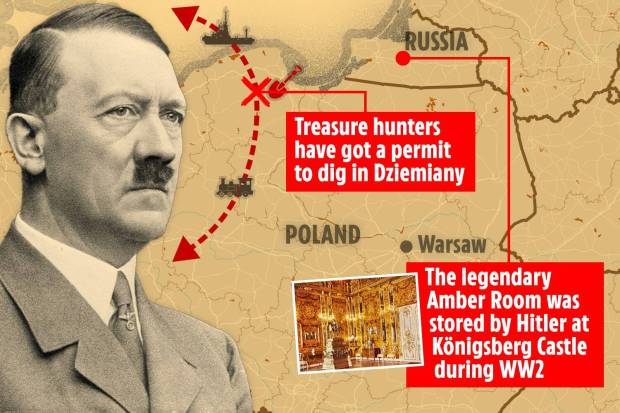World
New Search Approved for £250 Million Amber Room Treasure in Poland

A significant development has occurred in the quest for the fabled Nazi gold train, which is believed to hold up to £20 billion worth of treasure, including the legendary Amber Room. Polish authorities have granted permission for a new archaeological search in Dziemiany, located in the Kościerzyna district of northern Poland. This train, reportedly filled with gold, jewels, and priceless artifacts, has eluded treasure hunters, governments, and the Polish Army since the end of World War II.
The search was approved by the Gdańsk office for the Protection of Monuments, allowing for drilling and archaeological surveying in the area. According to Marcin Tymiński, spokesperson for the Pomeranian Voivodeship Conservator of Monuments, there is a possibility of locating a hidden German deposit, and some speculate it could even be the lost Amber Room.
Historical Context and Speculation
The Nazi military established a training ground in Dziemiany for SS units in late 1943. Jan Delingowski, a former merchant fleet radio officer, has dedicated the last decade to searching for the legendary train in the Kashubia region. In a recent interview on the YouTube channel History Hiking, Delingowski suggested a historical link between the suspected treasure site and Nazi official Erich Koch, who served as a Gauleiter in East Prussia from 1928 until 1945.
Following World War II, Koch was tried in Poland and convicted of war crimes, which included the deaths of approximately 400,000 Poles. Although he was sentenced to death in 1959, the execution was never carried out due to his poor health. However, declassified files from the Institute of National Remembrance (IPN) indicate that Polish authorities and the Soviet KGB may have held off on executing his sentence in hopes of extracting information about the location of the hidden treasure.
A New Search Begins
Delingowski claims that a former inmate who met Koch in the 1980s recounted that the Nazi official revealed the treasure’s hiding place shortly before his death. According to this account, the convoy transporting the treasure veered off the road “somewhere between Czersk and Człuchów, heading toward the Oder river.” The crates are thought to be hidden in a bunker disguised on a hill near a lake, which was once the site of SS barracks.
Previous explorations in the region have uncovered a brick tank, and based on Delingowski’s testimonies and research, authorities are now investigating the site further. The official decision from Polish authorities states, “Based on findings from prior heritage surveys, there is reason to believe that a World War II-era slit bunker is located on the plot, which may qualify as a historical monument. Furthermore, historic material, including archaeological artifacts, may be present inside and around it.”
The legend of the Nazi gold train has captivated treasure hunters and historians for decades. Known as the Wałbrzych gold train, it is said to contain not only gold and jewels but also the lost Amber Room, originally created for Russian Tsar Peter the Great in the 1700s. This ornate room was looted by the Nazis during their invasion of the Soviet Union in 1941 and is often referred to as the “Eighth Wonder of the World” due to its historical significance.
Despite numerous searches since 1945, including operations by the Polish Army during the Cold War, no trace of the train has been confirmed. Interest in the legend surged between 2015 and 2018 when two Polish treasure hunters claimed to have located the train using ground-penetrating radar. This assertion led to a high-profile excavation involving the Polish military and government officials, but the dig was ultimately abandoned when the supposed treasure turned out to be a natural geological formation.
As the search resumes, enthusiasts continue to hope that the legendary train, and the treasures it may hold, will one day be uncovered, further enriching the historical narrative of World War II and its aftermath.
-

 Health3 months ago
Health3 months agoNeurologist Warns Excessive Use of Supplements Can Harm Brain
-

 Health3 months ago
Health3 months agoFiona Phillips’ Husband Shares Heartfelt Update on Her Alzheimer’s Journey
-

 Science1 month ago
Science1 month agoBrian Cox Addresses Claims of Alien Probe in 3I/ATLAS Discovery
-

 Science1 month ago
Science1 month agoNASA Investigates Unusual Comet 3I/ATLAS; New Findings Emerge
-

 Science4 weeks ago
Science4 weeks agoScientists Examine 3I/ATLAS: Alien Artifact or Cosmic Oddity?
-

 Science4 weeks ago
Science4 weeks agoNASA Investigates Speedy Object 3I/ATLAS, Sparking Speculation
-

 Entertainment4 months ago
Entertainment4 months agoKerry Katona Discusses Future Baby Plans and Brian McFadden’s Wedding
-

 Entertainment4 months ago
Entertainment4 months agoEmmerdale Faces Tension as Dylan and April’s Lives Hang in the Balance
-

 World3 months ago
World3 months agoCole Palmer’s Cryptic Message to Kobbie Mainoo Following Loan Talks
-

 Science4 weeks ago
Science4 weeks agoNASA Scientists Explore Origins of 3I/ATLAS, a Fast-Moving Visitor
-

 Entertainment4 months ago
Entertainment4 months agoLove Island Star Toni Laite’s Mother Expresses Disappointment Over Coupling Decision
-

 Entertainment3 months ago
Entertainment3 months agoMajor Cast Changes at Coronation Street: Exits and Returns in 2025









